Developing People and Performance Assignment 2022
VerifiedAdded on 2022/10/11
|15
|2554
|7
Assignment
AI Summary
Contribute Materials
Your contribution can guide someone’s learning journey. Share your
documents today.
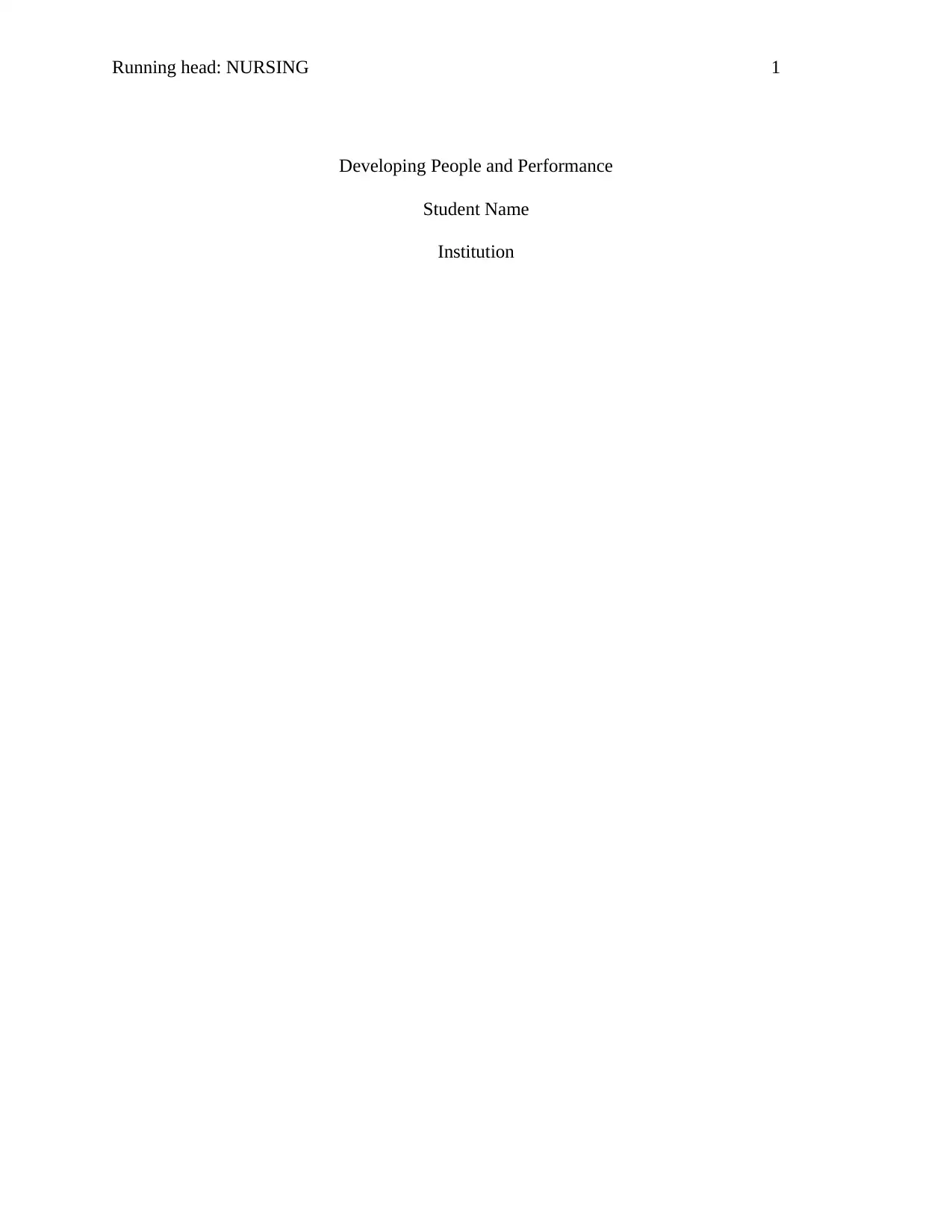
Running head: NURSING 1
Developing People and Performance
Student Name
Institution
Developing People and Performance
Student Name
Institution
Secure Best Marks with AI Grader
Need help grading? Try our AI Grader for instant feedback on your assignments.
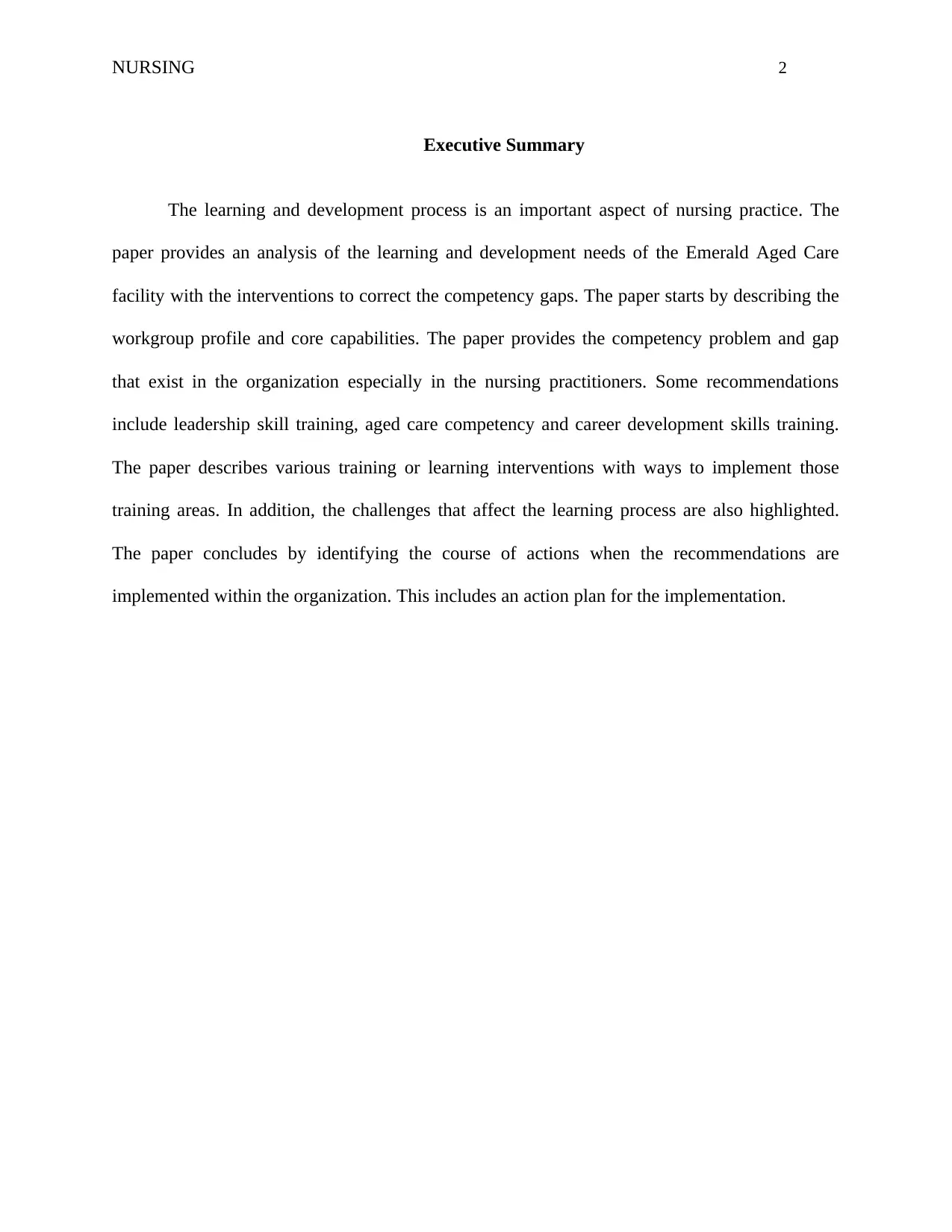
NURSING 2
Executive Summary
The learning and development process is an important aspect of nursing practice. The
paper provides an analysis of the learning and development needs of the Emerald Aged Care
facility with the interventions to correct the competency gaps. The paper starts by describing the
workgroup profile and core capabilities. The paper provides the competency problem and gap
that exist in the organization especially in the nursing practitioners. Some recommendations
include leadership skill training, aged care competency and career development skills training.
The paper describes various training or learning interventions with ways to implement those
training areas. In addition, the challenges that affect the learning process are also highlighted.
The paper concludes by identifying the course of actions when the recommendations are
implemented within the organization. This includes an action plan for the implementation.
Executive Summary
The learning and development process is an important aspect of nursing practice. The
paper provides an analysis of the learning and development needs of the Emerald Aged Care
facility with the interventions to correct the competency gaps. The paper starts by describing the
workgroup profile and core capabilities. The paper provides the competency problem and gap
that exist in the organization especially in the nursing practitioners. Some recommendations
include leadership skill training, aged care competency and career development skills training.
The paper describes various training or learning interventions with ways to implement those
training areas. In addition, the challenges that affect the learning process are also highlighted.
The paper concludes by identifying the course of actions when the recommendations are
implemented within the organization. This includes an action plan for the implementation.
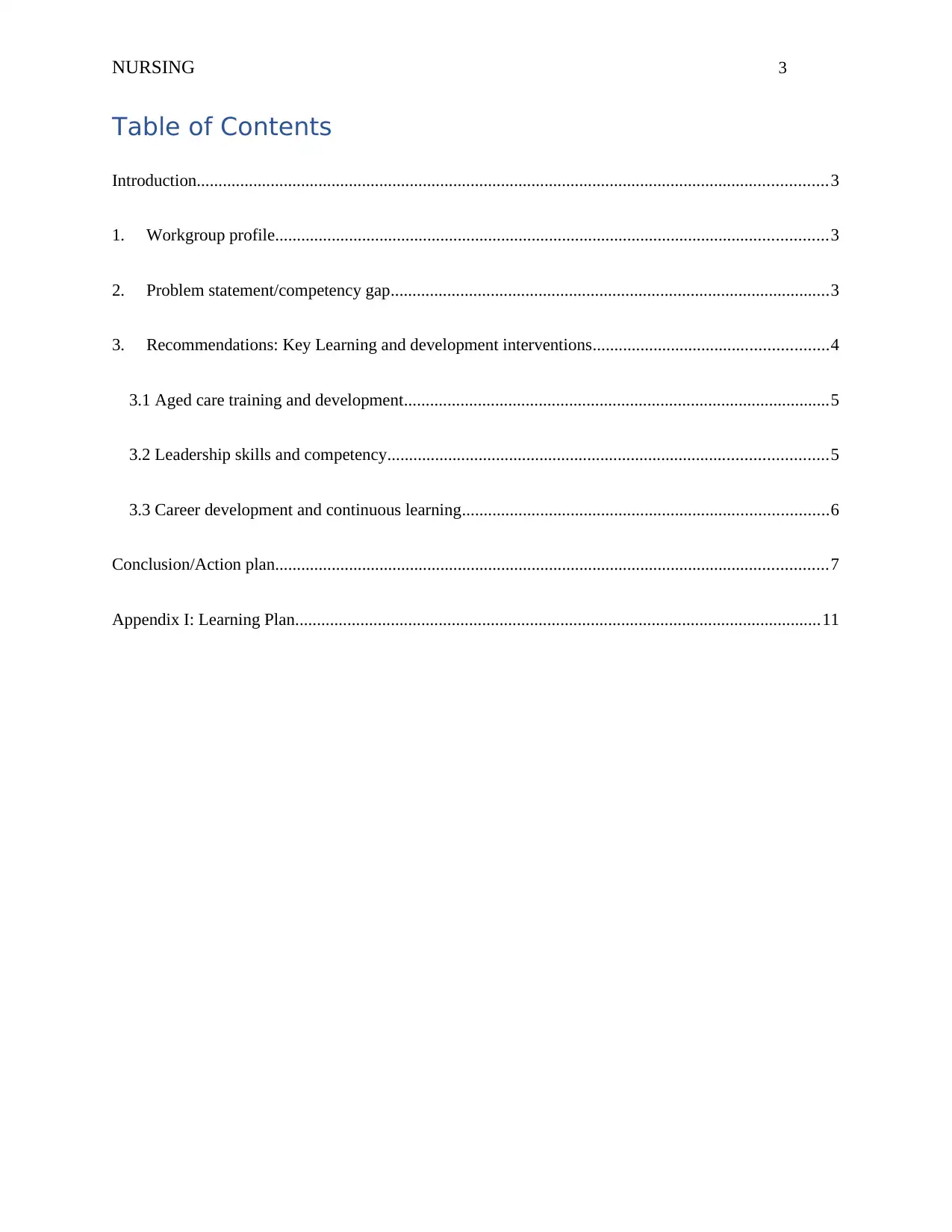
NURSING 3
Table of Contents
Introduction.................................................................................................................................................3
1. Workgroup profile...............................................................................................................................3
2. Problem statement/competency gap.....................................................................................................3
3. Recommendations: Key Learning and development interventions......................................................4
3.1 Aged care training and development..................................................................................................5
3.2 Leadership skills and competency.....................................................................................................5
3.3 Career development and continuous learning....................................................................................6
Conclusion/Action plan...............................................................................................................................7
Appendix I: Learning Plan.........................................................................................................................11
Table of Contents
Introduction.................................................................................................................................................3
1. Workgroup profile...............................................................................................................................3
2. Problem statement/competency gap.....................................................................................................3
3. Recommendations: Key Learning and development interventions......................................................4
3.1 Aged care training and development..................................................................................................5
3.2 Leadership skills and competency.....................................................................................................5
3.3 Career development and continuous learning....................................................................................6
Conclusion/Action plan...............................................................................................................................7
Appendix I: Learning Plan.........................................................................................................................11
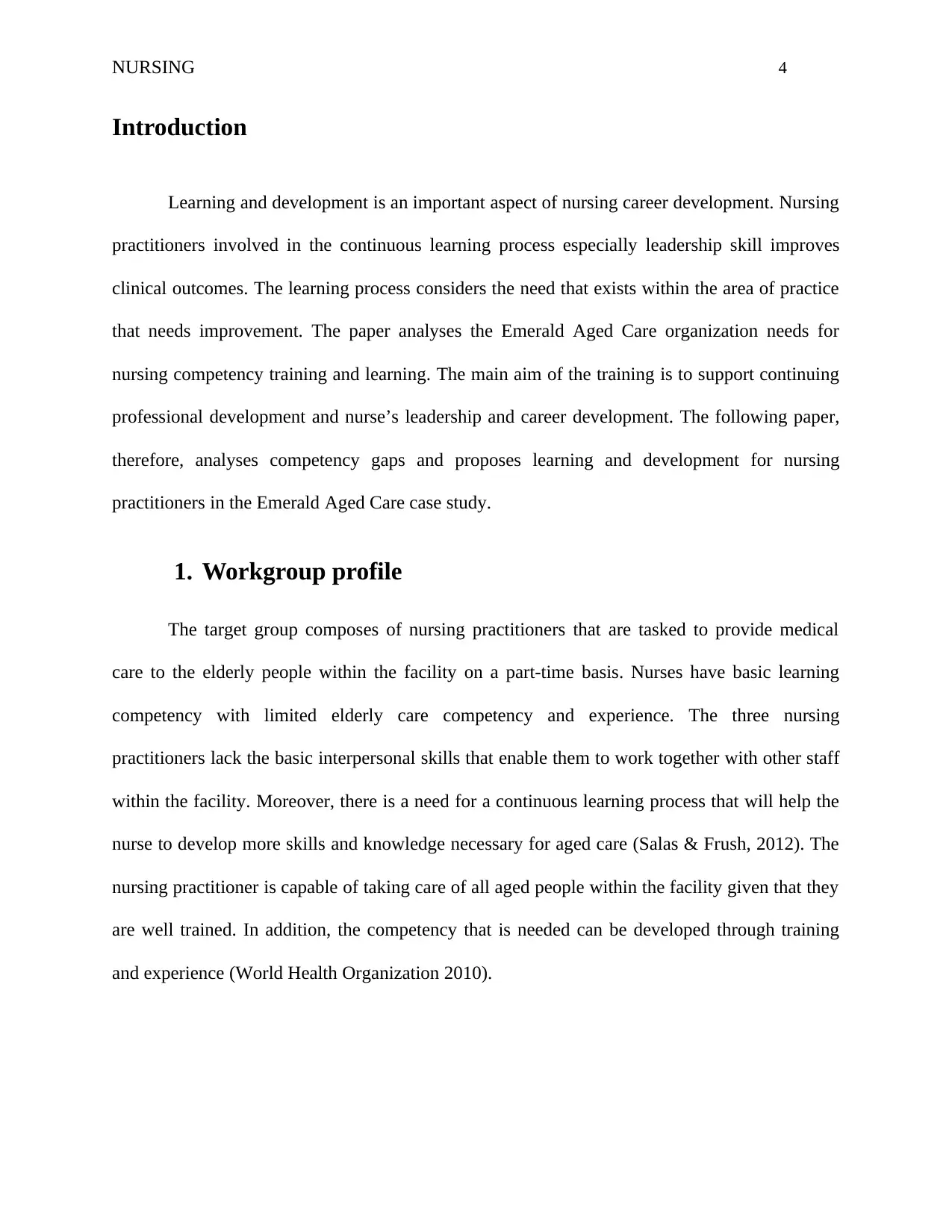
NURSING 4
Introduction
Learning and development is an important aspect of nursing career development. Nursing
practitioners involved in the continuous learning process especially leadership skill improves
clinical outcomes. The learning process considers the need that exists within the area of practice
that needs improvement. The paper analyses the Emerald Aged Care organization needs for
nursing competency training and learning. The main aim of the training is to support continuing
professional development and nurse’s leadership and career development. The following paper,
therefore, analyses competency gaps and proposes learning and development for nursing
practitioners in the Emerald Aged Care case study.
1. Workgroup profile
The target group composes of nursing practitioners that are tasked to provide medical
care to the elderly people within the facility on a part-time basis. Nurses have basic learning
competency with limited elderly care competency and experience. The three nursing
practitioners lack the basic interpersonal skills that enable them to work together with other staff
within the facility. Moreover, there is a need for a continuous learning process that will help the
nurse to develop more skills and knowledge necessary for aged care (Salas & Frush, 2012). The
nursing practitioner is capable of taking care of all aged people within the facility given that they
are well trained. In addition, the competency that is needed can be developed through training
and experience (World Health Organization 2010).
Introduction
Learning and development is an important aspect of nursing career development. Nursing
practitioners involved in the continuous learning process especially leadership skill improves
clinical outcomes. The learning process considers the need that exists within the area of practice
that needs improvement. The paper analyses the Emerald Aged Care organization needs for
nursing competency training and learning. The main aim of the training is to support continuing
professional development and nurse’s leadership and career development. The following paper,
therefore, analyses competency gaps and proposes learning and development for nursing
practitioners in the Emerald Aged Care case study.
1. Workgroup profile
The target group composes of nursing practitioners that are tasked to provide medical
care to the elderly people within the facility on a part-time basis. Nurses have basic learning
competency with limited elderly care competency and experience. The three nursing
practitioners lack the basic interpersonal skills that enable them to work together with other staff
within the facility. Moreover, there is a need for a continuous learning process that will help the
nurse to develop more skills and knowledge necessary for aged care (Salas & Frush, 2012). The
nursing practitioner is capable of taking care of all aged people within the facility given that they
are well trained. In addition, the competency that is needed can be developed through training
and experience (World Health Organization 2010).
Secure Best Marks with AI Grader
Need help grading? Try our AI Grader for instant feedback on your assignments.
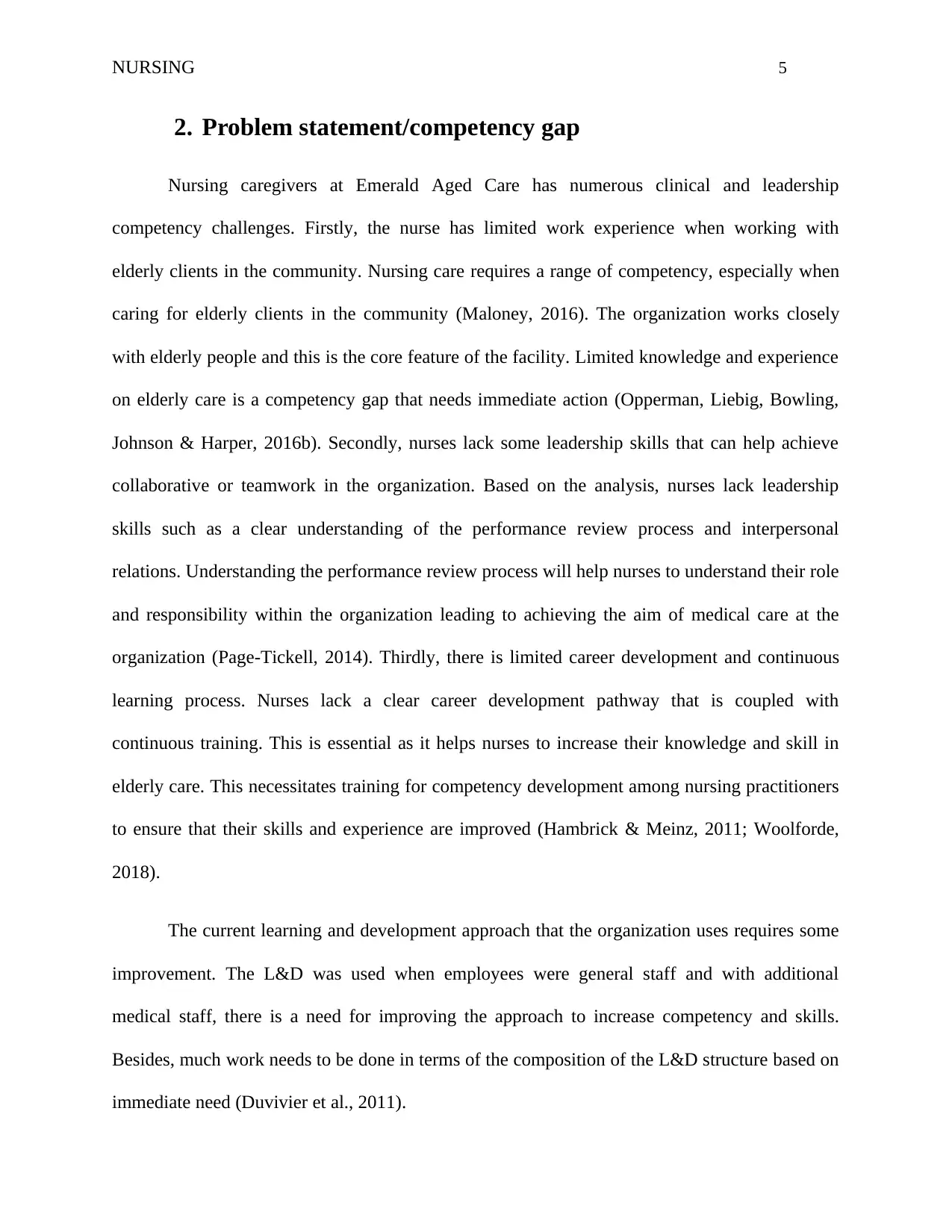
NURSING 5
2. Problem statement/competency gap
Nursing caregivers at Emerald Aged Care has numerous clinical and leadership
competency challenges. Firstly, the nurse has limited work experience when working with
elderly clients in the community. Nursing care requires a range of competency, especially when
caring for elderly clients in the community (Maloney, 2016). The organization works closely
with elderly people and this is the core feature of the facility. Limited knowledge and experience
on elderly care is a competency gap that needs immediate action (Opperman, Liebig, Bowling,
Johnson & Harper, 2016b). Secondly, nurses lack some leadership skills that can help achieve
collaborative or teamwork in the organization. Based on the analysis, nurses lack leadership
skills such as a clear understanding of the performance review process and interpersonal
relations. Understanding the performance review process will help nurses to understand their role
and responsibility within the organization leading to achieving the aim of medical care at the
organization (Page-Tickell, 2014). Thirdly, there is limited career development and continuous
learning process. Nurses lack a clear career development pathway that is coupled with
continuous training. This is essential as it helps nurses to increase their knowledge and skill in
elderly care. This necessitates training for competency development among nursing practitioners
to ensure that their skills and experience are improved (Hambrick & Meinz, 2011; Woolforde,
2018).
The current learning and development approach that the organization uses requires some
improvement. The L&D was used when employees were general staff and with additional
medical staff, there is a need for improving the approach to increase competency and skills.
Besides, much work needs to be done in terms of the composition of the L&D structure based on
immediate need (Duvivier et al., 2011).
2. Problem statement/competency gap
Nursing caregivers at Emerald Aged Care has numerous clinical and leadership
competency challenges. Firstly, the nurse has limited work experience when working with
elderly clients in the community. Nursing care requires a range of competency, especially when
caring for elderly clients in the community (Maloney, 2016). The organization works closely
with elderly people and this is the core feature of the facility. Limited knowledge and experience
on elderly care is a competency gap that needs immediate action (Opperman, Liebig, Bowling,
Johnson & Harper, 2016b). Secondly, nurses lack some leadership skills that can help achieve
collaborative or teamwork in the organization. Based on the analysis, nurses lack leadership
skills such as a clear understanding of the performance review process and interpersonal
relations. Understanding the performance review process will help nurses to understand their role
and responsibility within the organization leading to achieving the aim of medical care at the
organization (Page-Tickell, 2014). Thirdly, there is limited career development and continuous
learning process. Nurses lack a clear career development pathway that is coupled with
continuous training. This is essential as it helps nurses to increase their knowledge and skill in
elderly care. This necessitates training for competency development among nursing practitioners
to ensure that their skills and experience are improved (Hambrick & Meinz, 2011; Woolforde,
2018).
The current learning and development approach that the organization uses requires some
improvement. The L&D was used when employees were general staff and with additional
medical staff, there is a need for improving the approach to increase competency and skills.
Besides, much work needs to be done in terms of the composition of the L&D structure based on
immediate need (Duvivier et al., 2011).

NURSING 6
3. Recommendations: Key Human Resource Development
(HRD) interventions
There are some proposed HRD interventions to improve on the competency and
experience of the nursing workgroup within the Emerald Aged Care medical facility. These
interventions are grouped into three areas that are important for the training of the nurses.
3.1 Aged care training and development
There is a need for elderly care training for nurses to improve their understanding and
experience with elderly people. The intervention addresses various design considerations that
include the transfer of training as nurses will be expected to practice what has been learned on
caring for elderly people that form main users of the facility (Guillermo & Fernand, 2011).
Moreover, the learner career profile is also improved as they will have a wider knowledge base
on working with elderly people. The implementation of the training will require the appointment
of the medical center manager that will lead the training and evaluation of the training. The
manager will be reporting to the HR General Manager on the progress of training and working at
the facility (Opperman, Liebig, Bowling, Johnson & Harper, 2016). The learning should be
structured formal that include elderly care, teamwork, and dynamic health care. Learning should
take at least three months with trainers coming to the medical facility for training. At the end of
the training, nurses will be assessed and report writer to the HR General Manager of the outcome
of training. The challenge that is most likely to affect the training is limited time for training and
actual duty on the facility given the number of nurses (Committee on the Robert Wood Johnson
Foundation Initiative on the Future of Nursing at the Institute of Medicine, 2011).
3. Recommendations: Key Human Resource Development
(HRD) interventions
There are some proposed HRD interventions to improve on the competency and
experience of the nursing workgroup within the Emerald Aged Care medical facility. These
interventions are grouped into three areas that are important for the training of the nurses.
3.1 Aged care training and development
There is a need for elderly care training for nurses to improve their understanding and
experience with elderly people. The intervention addresses various design considerations that
include the transfer of training as nurses will be expected to practice what has been learned on
caring for elderly people that form main users of the facility (Guillermo & Fernand, 2011).
Moreover, the learner career profile is also improved as they will have a wider knowledge base
on working with elderly people. The implementation of the training will require the appointment
of the medical center manager that will lead the training and evaluation of the training. The
manager will be reporting to the HR General Manager on the progress of training and working at
the facility (Opperman, Liebig, Bowling, Johnson & Harper, 2016). The learning should be
structured formal that include elderly care, teamwork, and dynamic health care. Learning should
take at least three months with trainers coming to the medical facility for training. At the end of
the training, nurses will be assessed and report writer to the HR General Manager of the outcome
of training. The challenge that is most likely to affect the training is limited time for training and
actual duty on the facility given the number of nurses (Committee on the Robert Wood Johnson
Foundation Initiative on the Future of Nursing at the Institute of Medicine, 2011).
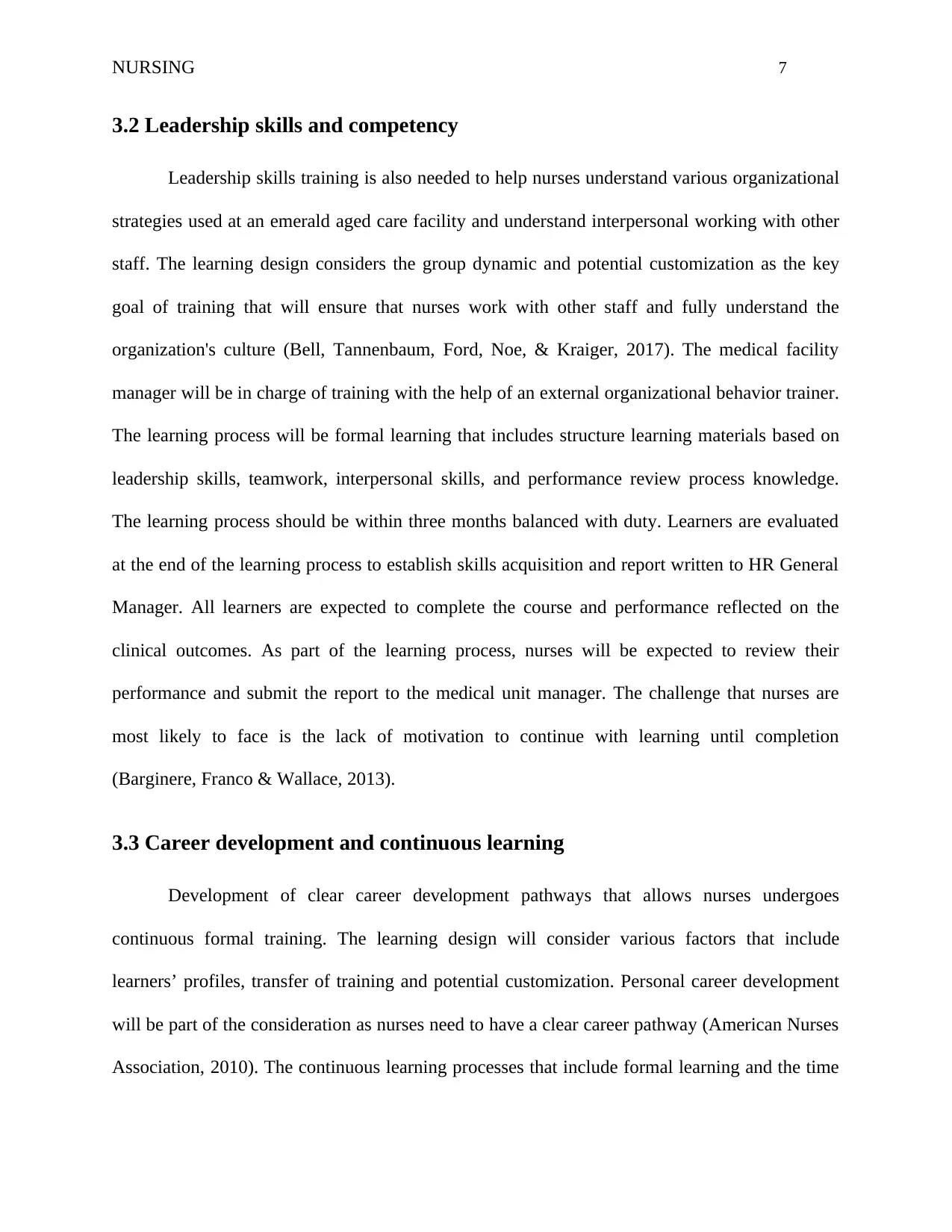
NURSING 7
3.2 Leadership skills and competency
Leadership skills training is also needed to help nurses understand various organizational
strategies used at an emerald aged care facility and understand interpersonal working with other
staff. The learning design considers the group dynamic and potential customization as the key
goal of training that will ensure that nurses work with other staff and fully understand the
organization's culture (Bell, Tannenbaum, Ford, Noe, & Kraiger, 2017). The medical facility
manager will be in charge of training with the help of an external organizational behavior trainer.
The learning process will be formal learning that includes structure learning materials based on
leadership skills, teamwork, interpersonal skills, and performance review process knowledge.
The learning process should be within three months balanced with duty. Learners are evaluated
at the end of the learning process to establish skills acquisition and report written to HR General
Manager. All learners are expected to complete the course and performance reflected on the
clinical outcomes. As part of the learning process, nurses will be expected to review their
performance and submit the report to the medical unit manager. The challenge that nurses are
most likely to face is the lack of motivation to continue with learning until completion
(Barginere, Franco & Wallace, 2013).
3.3 Career development and continuous learning
Development of clear career development pathways that allows nurses undergoes
continuous formal training. The learning design will consider various factors that include
learners’ profiles, transfer of training and potential customization. Personal career development
will be part of the consideration as nurses need to have a clear career pathway (American Nurses
Association, 2010). The continuous learning processes that include formal learning and the time
3.2 Leadership skills and competency
Leadership skills training is also needed to help nurses understand various organizational
strategies used at an emerald aged care facility and understand interpersonal working with other
staff. The learning design considers the group dynamic and potential customization as the key
goal of training that will ensure that nurses work with other staff and fully understand the
organization's culture (Bell, Tannenbaum, Ford, Noe, & Kraiger, 2017). The medical facility
manager will be in charge of training with the help of an external organizational behavior trainer.
The learning process will be formal learning that includes structure learning materials based on
leadership skills, teamwork, interpersonal skills, and performance review process knowledge.
The learning process should be within three months balanced with duty. Learners are evaluated
at the end of the learning process to establish skills acquisition and report written to HR General
Manager. All learners are expected to complete the course and performance reflected on the
clinical outcomes. As part of the learning process, nurses will be expected to review their
performance and submit the report to the medical unit manager. The challenge that nurses are
most likely to face is the lack of motivation to continue with learning until completion
(Barginere, Franco & Wallace, 2013).
3.3 Career development and continuous learning
Development of clear career development pathways that allows nurses undergoes
continuous formal training. The learning design will consider various factors that include
learners’ profiles, transfer of training and potential customization. Personal career development
will be part of the consideration as nurses need to have a clear career pathway (American Nurses
Association, 2010). The continuous learning processes that include formal learning and the time
Paraphrase This Document
Need a fresh take? Get an instant paraphrase of this document with our AI Paraphraser
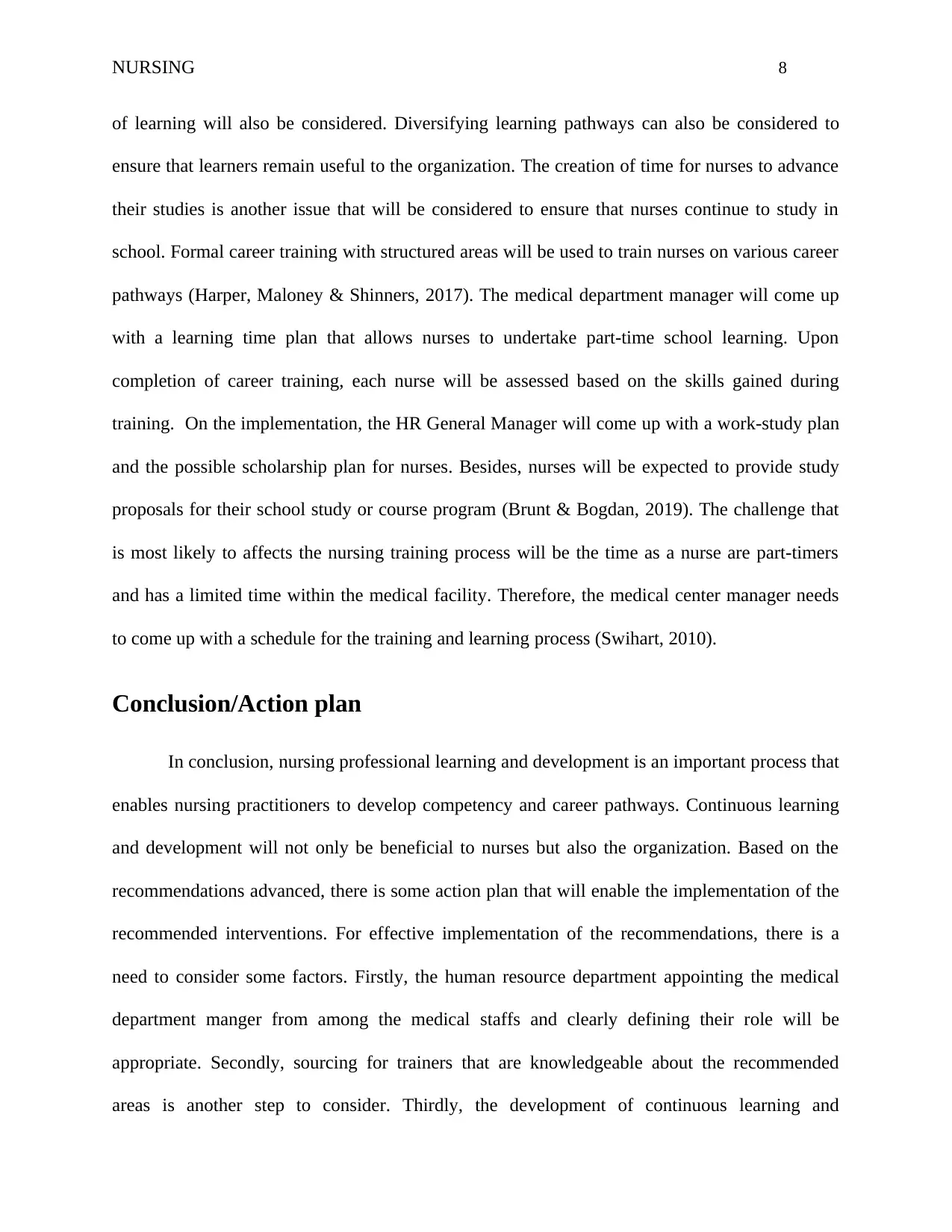
NURSING 8
of learning will also be considered. Diversifying learning pathways can also be considered to
ensure that learners remain useful to the organization. The creation of time for nurses to advance
their studies is another issue that will be considered to ensure that nurses continue to study in
school. Formal career training with structured areas will be used to train nurses on various career
pathways (Harper, Maloney & Shinners, 2017). The medical department manager will come up
with a learning time plan that allows nurses to undertake part-time school learning. Upon
completion of career training, each nurse will be assessed based on the skills gained during
training. On the implementation, the HR General Manager will come up with a work-study plan
and the possible scholarship plan for nurses. Besides, nurses will be expected to provide study
proposals for their school study or course program (Brunt & Bogdan, 2019). The challenge that
is most likely to affects the nursing training process will be the time as a nurse are part-timers
and has a limited time within the medical facility. Therefore, the medical center manager needs
to come up with a schedule for the training and learning process (Swihart, 2010).
Conclusion/Action plan
In conclusion, nursing professional learning and development is an important process that
enables nursing practitioners to develop competency and career pathways. Continuous learning
and development will not only be beneficial to nurses but also the organization. Based on the
recommendations advanced, there is some action plan that will enable the implementation of the
recommended interventions. For effective implementation of the recommendations, there is a
need to consider some factors. Firstly, the human resource department appointing the medical
department manger from among the medical staffs and clearly defining their role will be
appropriate. Secondly, sourcing for trainers that are knowledgeable about the recommended
areas is another step to consider. Thirdly, the development of continuous learning and
of learning will also be considered. Diversifying learning pathways can also be considered to
ensure that learners remain useful to the organization. The creation of time for nurses to advance
their studies is another issue that will be considered to ensure that nurses continue to study in
school. Formal career training with structured areas will be used to train nurses on various career
pathways (Harper, Maloney & Shinners, 2017). The medical department manager will come up
with a learning time plan that allows nurses to undertake part-time school learning. Upon
completion of career training, each nurse will be assessed based on the skills gained during
training. On the implementation, the HR General Manager will come up with a work-study plan
and the possible scholarship plan for nurses. Besides, nurses will be expected to provide study
proposals for their school study or course program (Brunt & Bogdan, 2019). The challenge that
is most likely to affects the nursing training process will be the time as a nurse are part-timers
and has a limited time within the medical facility. Therefore, the medical center manager needs
to come up with a schedule for the training and learning process (Swihart, 2010).
Conclusion/Action plan
In conclusion, nursing professional learning and development is an important process that
enables nursing practitioners to develop competency and career pathways. Continuous learning
and development will not only be beneficial to nurses but also the organization. Based on the
recommendations advanced, there is some action plan that will enable the implementation of the
recommended interventions. For effective implementation of the recommendations, there is a
need to consider some factors. Firstly, the human resource department appointing the medical
department manger from among the medical staffs and clearly defining their role will be
appropriate. Secondly, sourcing for trainers that are knowledgeable about the recommended
areas is another step to consider. Thirdly, the development of continuous learning and

NURSING 9
development structure will assist all staff within the organization. Fourthly, the development of a
clear career development plan that will help staff to further their studies in their respective skills
is also necessary. Lastly, the human resource considers updating their LMS and performance
management system to include the nursing performance and learning development system
recommended (Garrison & Beverage, 2018).
development structure will assist all staff within the organization. Fourthly, the development of a
clear career development plan that will help staff to further their studies in their respective skills
is also necessary. Lastly, the human resource considers updating their LMS and performance
management system to include the nursing performance and learning development system
recommended (Garrison & Beverage, 2018).

NURSING 10
Reference
American Nurses Association. (2010). Nursing’s social policy statement: The essence of the
profession. Silver Spring, MD: Nursesbooks.org
Barginere, C., Franco, S., & Wallace, L. (2013). Succession planning in an academic medical
center nursing service. Nursing Administration Quarterly, 37(1), 67-71.
Bell, B. S., Tannenbaum, S. I., Ford, J. K., Noe, R. A., & Kraiger, K. (2017). 100 years of
training and development research: What we know and where we should go. Journal of
Applied Psychology. 102 (3): 305–323. DOI: 10.1037/apl0000142.
Brunt, B.A., & Bogdan, B.A. (Jun 3, 2019). Nursing Professional Development (NPD)
Leadership, StatPearls [Internet]. Treasure Island (FL): StatPearls Publishing. Retrieved
from https://www.ncbi.nlm.nih.gov/pubmed/30085606
Committee on the Robert Wood Johnson Foundation Initiative on the Future of Nursing at the
Institute of Medicine. (2011). The future of nursing: Leading change, advancing health.
Washington, D. C.: National Academies Press.
Duvivier, R. J., van Dalen, J., Muijtjens, A. M., Moulaert, V., Van der Vleuten, C., &
Scherpbier, A. (2011). The role of deliberate practice in the acquisition of clinical skills.
BMC Medical Education, 11: 101.
Garrison, E., & Beverage, J. (2018). Implementing a Process to Measure Return on Investment
for Nursing Professional Development. J Nurses Prof Dev., 34(1):8-11. Retrieved from
https://www.ncbi.nlm.nih.gov/pubmed/29298222
Reference
American Nurses Association. (2010). Nursing’s social policy statement: The essence of the
profession. Silver Spring, MD: Nursesbooks.org
Barginere, C., Franco, S., & Wallace, L. (2013). Succession planning in an academic medical
center nursing service. Nursing Administration Quarterly, 37(1), 67-71.
Bell, B. S., Tannenbaum, S. I., Ford, J. K., Noe, R. A., & Kraiger, K. (2017). 100 years of
training and development research: What we know and where we should go. Journal of
Applied Psychology. 102 (3): 305–323. DOI: 10.1037/apl0000142.
Brunt, B.A., & Bogdan, B.A. (Jun 3, 2019). Nursing Professional Development (NPD)
Leadership, StatPearls [Internet]. Treasure Island (FL): StatPearls Publishing. Retrieved
from https://www.ncbi.nlm.nih.gov/pubmed/30085606
Committee on the Robert Wood Johnson Foundation Initiative on the Future of Nursing at the
Institute of Medicine. (2011). The future of nursing: Leading change, advancing health.
Washington, D. C.: National Academies Press.
Duvivier, R. J., van Dalen, J., Muijtjens, A. M., Moulaert, V., Van der Vleuten, C., &
Scherpbier, A. (2011). The role of deliberate practice in the acquisition of clinical skills.
BMC Medical Education, 11: 101.
Garrison, E., & Beverage, J. (2018). Implementing a Process to Measure Return on Investment
for Nursing Professional Development. J Nurses Prof Dev., 34(1):8-11. Retrieved from
https://www.ncbi.nlm.nih.gov/pubmed/29298222
Secure Best Marks with AI Grader
Need help grading? Try our AI Grader for instant feedback on your assignments.
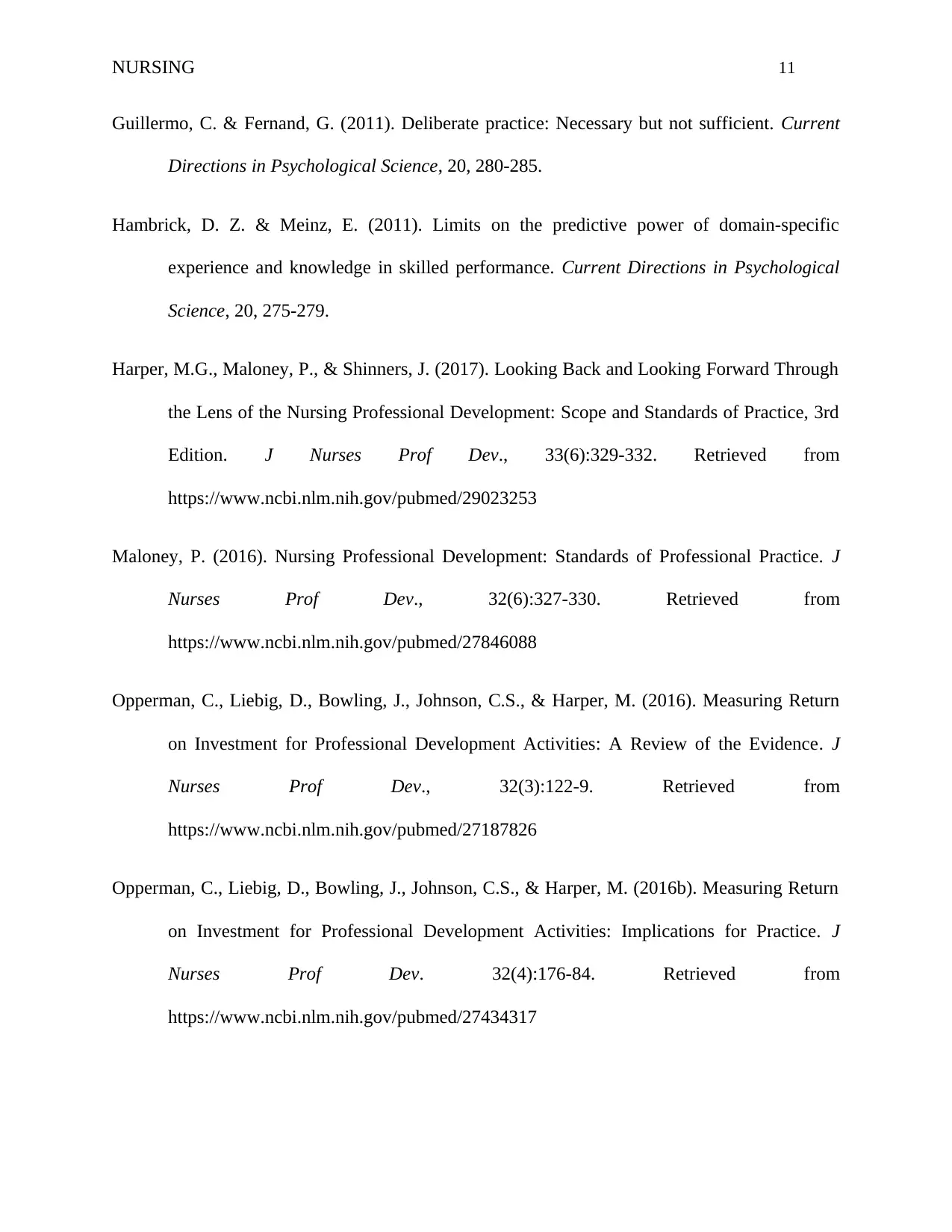
NURSING 11
Guillermo, C. & Fernand, G. (2011). Deliberate practice: Necessary but not sufficient. Current
Directions in Psychological Science, 20, 280-285.
Hambrick, D. Z. & Meinz, E. (2011). Limits on the predictive power of domain-specific
experience and knowledge in skilled performance. Current Directions in Psychological
Science, 20, 275-279.
Harper, M.G., Maloney, P., & Shinners, J. (2017). Looking Back and Looking Forward Through
the Lens of the Nursing Professional Development: Scope and Standards of Practice, 3rd
Edition. J Nurses Prof Dev., 33(6):329-332. Retrieved from
https://www.ncbi.nlm.nih.gov/pubmed/29023253
Maloney, P. (2016). Nursing Professional Development: Standards of Professional Practice. J
Nurses Prof Dev., 32(6):327-330. Retrieved from
https://www.ncbi.nlm.nih.gov/pubmed/27846088
Opperman, C., Liebig, D., Bowling, J., Johnson, C.S., & Harper, M. (2016). Measuring Return
on Investment for Professional Development Activities: A Review of the Evidence. J
Nurses Prof Dev., 32(3):122-9. Retrieved from
https://www.ncbi.nlm.nih.gov/pubmed/27187826
Opperman, C., Liebig, D., Bowling, J., Johnson, C.S., & Harper, M. (2016b). Measuring Return
on Investment for Professional Development Activities: Implications for Practice. J
Nurses Prof Dev. 32(4):176-84. Retrieved from
https://www.ncbi.nlm.nih.gov/pubmed/27434317
Guillermo, C. & Fernand, G. (2011). Deliberate practice: Necessary but not sufficient. Current
Directions in Psychological Science, 20, 280-285.
Hambrick, D. Z. & Meinz, E. (2011). Limits on the predictive power of domain-specific
experience and knowledge in skilled performance. Current Directions in Psychological
Science, 20, 275-279.
Harper, M.G., Maloney, P., & Shinners, J. (2017). Looking Back and Looking Forward Through
the Lens of the Nursing Professional Development: Scope and Standards of Practice, 3rd
Edition. J Nurses Prof Dev., 33(6):329-332. Retrieved from
https://www.ncbi.nlm.nih.gov/pubmed/29023253
Maloney, P. (2016). Nursing Professional Development: Standards of Professional Practice. J
Nurses Prof Dev., 32(6):327-330. Retrieved from
https://www.ncbi.nlm.nih.gov/pubmed/27846088
Opperman, C., Liebig, D., Bowling, J., Johnson, C.S., & Harper, M. (2016). Measuring Return
on Investment for Professional Development Activities: A Review of the Evidence. J
Nurses Prof Dev., 32(3):122-9. Retrieved from
https://www.ncbi.nlm.nih.gov/pubmed/27187826
Opperman, C., Liebig, D., Bowling, J., Johnson, C.S., & Harper, M. (2016b). Measuring Return
on Investment for Professional Development Activities: Implications for Practice. J
Nurses Prof Dev. 32(4):176-84. Retrieved from
https://www.ncbi.nlm.nih.gov/pubmed/27434317
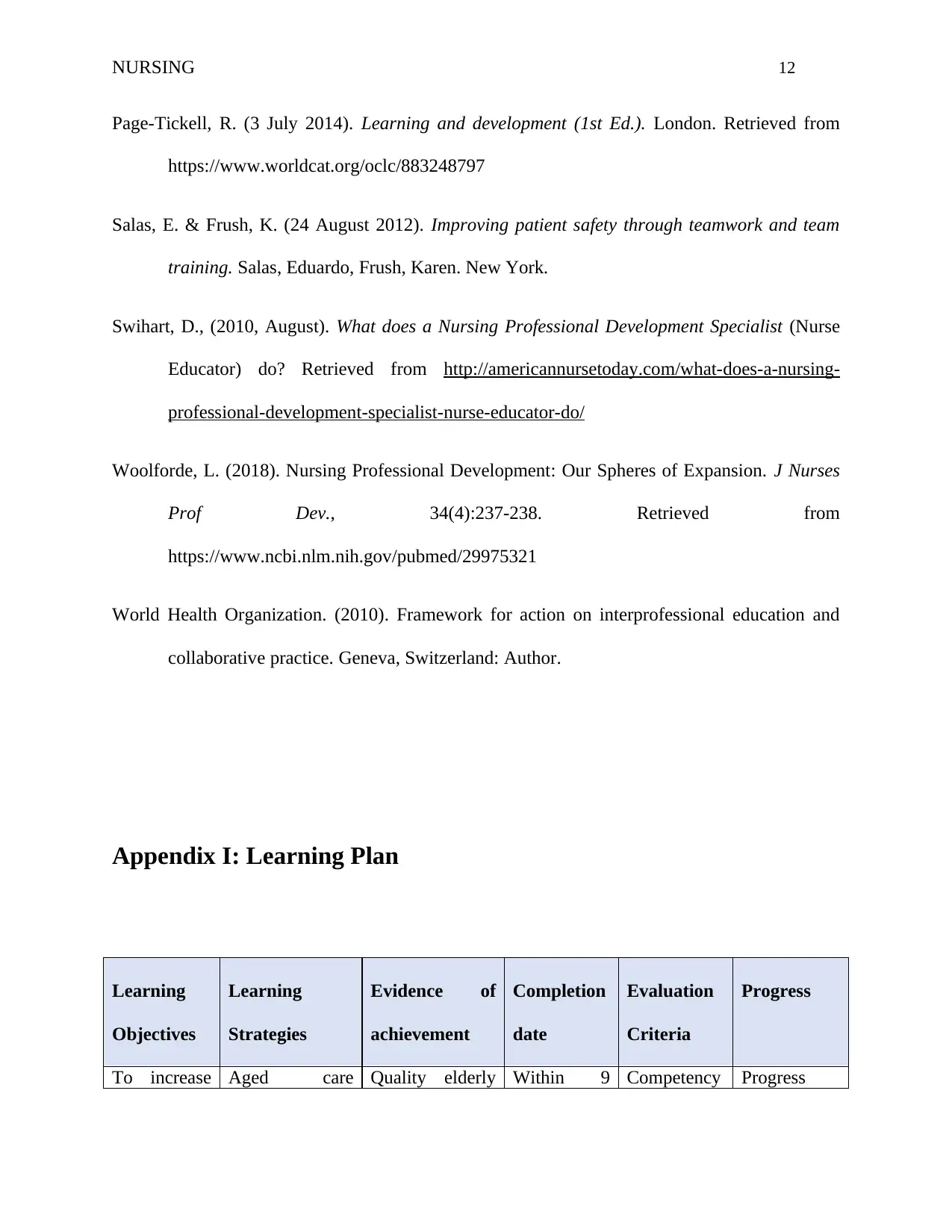
NURSING 12
Page-Tickell, R. (3 July 2014). Learning and development (1st Ed.). London. Retrieved from
https://www.worldcat.org/oclc/883248797
Salas, E. & Frush, K. (24 August 2012). Improving patient safety through teamwork and team
training. Salas, Eduardo, Frush, Karen. New York.
Swihart, D., (2010, August). What does a Nursing Professional Development Specialist (Nurse
Educator) do? Retrieved from http://americannursetoday.com/what-does-a-nursing-
professional-development-specialist-nurse-educator-do/
Woolforde, L. (2018). Nursing Professional Development: Our Spheres of Expansion. J Nurses
Prof Dev., 34(4):237-238. Retrieved from
https://www.ncbi.nlm.nih.gov/pubmed/29975321
World Health Organization. (2010). Framework for action on interprofessional education and
collaborative practice. Geneva, Switzerland: Author.
Appendix I: Learning Plan
Learning
Objectives
Learning
Strategies
Evidence of
achievement
Completion
date
Evaluation
Criteria
Progress
To increase Aged care Quality elderly Within 9 Competency Progress
Page-Tickell, R. (3 July 2014). Learning and development (1st Ed.). London. Retrieved from
https://www.worldcat.org/oclc/883248797
Salas, E. & Frush, K. (24 August 2012). Improving patient safety through teamwork and team
training. Salas, Eduardo, Frush, Karen. New York.
Swihart, D., (2010, August). What does a Nursing Professional Development Specialist (Nurse
Educator) do? Retrieved from http://americannursetoday.com/what-does-a-nursing-
professional-development-specialist-nurse-educator-do/
Woolforde, L. (2018). Nursing Professional Development: Our Spheres of Expansion. J Nurses
Prof Dev., 34(4):237-238. Retrieved from
https://www.ncbi.nlm.nih.gov/pubmed/29975321
World Health Organization. (2010). Framework for action on interprofessional education and
collaborative practice. Geneva, Switzerland: Author.
Appendix I: Learning Plan
Learning
Objectives
Learning
Strategies
Evidence of
achievement
Completion
date
Evaluation
Criteria
Progress
To increase Aged care Quality elderly Within 9 Competency Progress
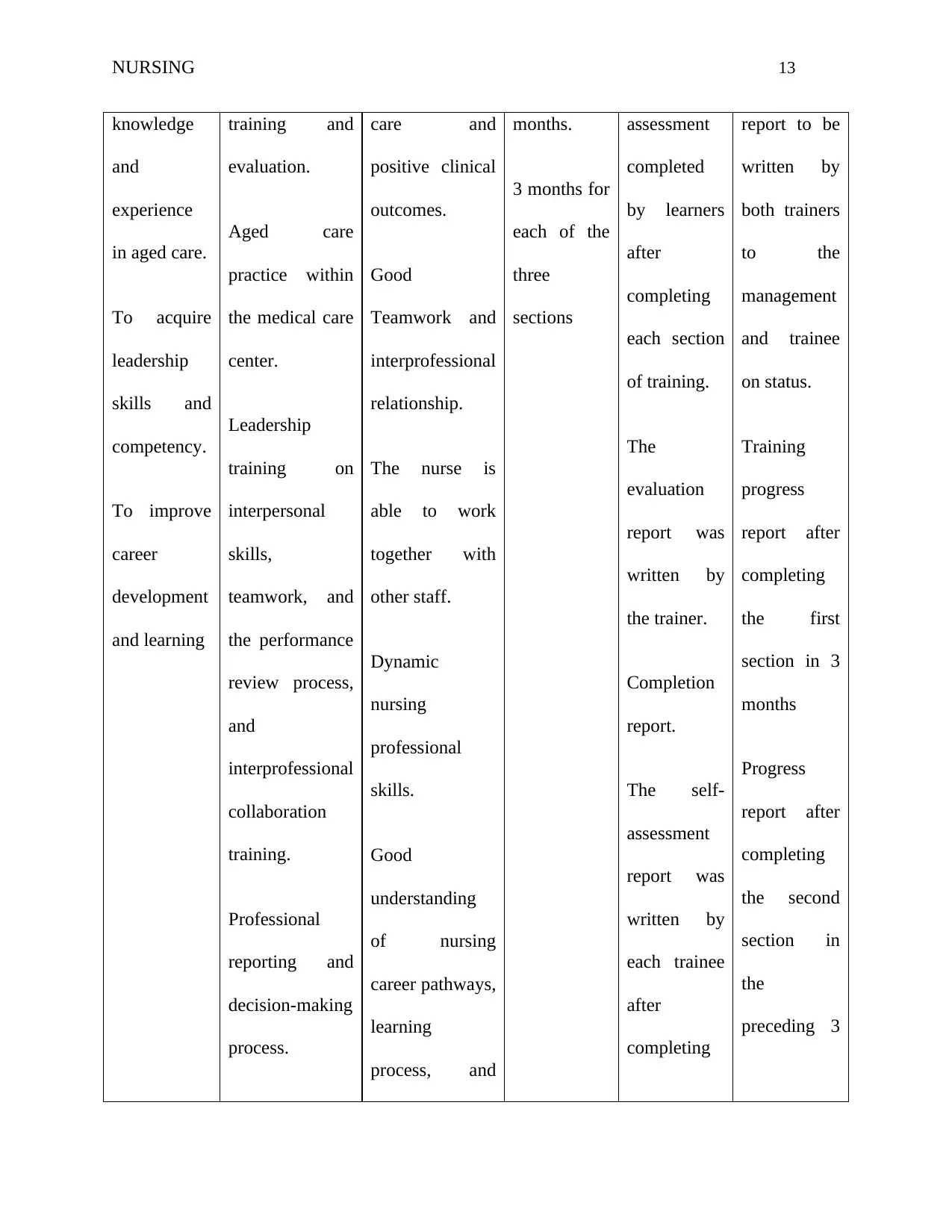
NURSING 13
knowledge
and
experience
in aged care.
To acquire
leadership
skills and
competency.
To improve
career
development
and learning
training and
evaluation.
Aged care
practice within
the medical care
center.
Leadership
training on
interpersonal
skills,
teamwork, and
the performance
review process,
and
interprofessional
collaboration
training.
Professional
reporting and
decision-making
process.
care and
positive clinical
outcomes.
Good
Teamwork and
interprofessional
relationship.
The nurse is
able to work
together with
other staff.
Dynamic
nursing
professional
skills.
Good
understanding
of nursing
career pathways,
learning
process, and
months.
3 months for
each of the
three
sections
assessment
completed
by learners
after
completing
each section
of training.
The
evaluation
report was
written by
the trainer.
Completion
report.
The self-
assessment
report was
written by
each trainee
after
completing
report to be
written by
both trainers
to the
management
and trainee
on status.
Training
progress
report after
completing
the first
section in 3
months
Progress
report after
completing
the second
section in
the
preceding 3
knowledge
and
experience
in aged care.
To acquire
leadership
skills and
competency.
To improve
career
development
and learning
training and
evaluation.
Aged care
practice within
the medical care
center.
Leadership
training on
interpersonal
skills,
teamwork, and
the performance
review process,
and
interprofessional
collaboration
training.
Professional
reporting and
decision-making
process.
care and
positive clinical
outcomes.
Good
Teamwork and
interprofessional
relationship.
The nurse is
able to work
together with
other staff.
Dynamic
nursing
professional
skills.
Good
understanding
of nursing
career pathways,
learning
process, and
months.
3 months for
each of the
three
sections
assessment
completed
by learners
after
completing
each section
of training.
The
evaluation
report was
written by
the trainer.
Completion
report.
The self-
assessment
report was
written by
each trainee
after
completing
report to be
written by
both trainers
to the
management
and trainee
on status.
Training
progress
report after
completing
the first
section in 3
months
Progress
report after
completing
the second
section in
the
preceding 3
Paraphrase This Document
Need a fresh take? Get an instant paraphrase of this document with our AI Paraphraser
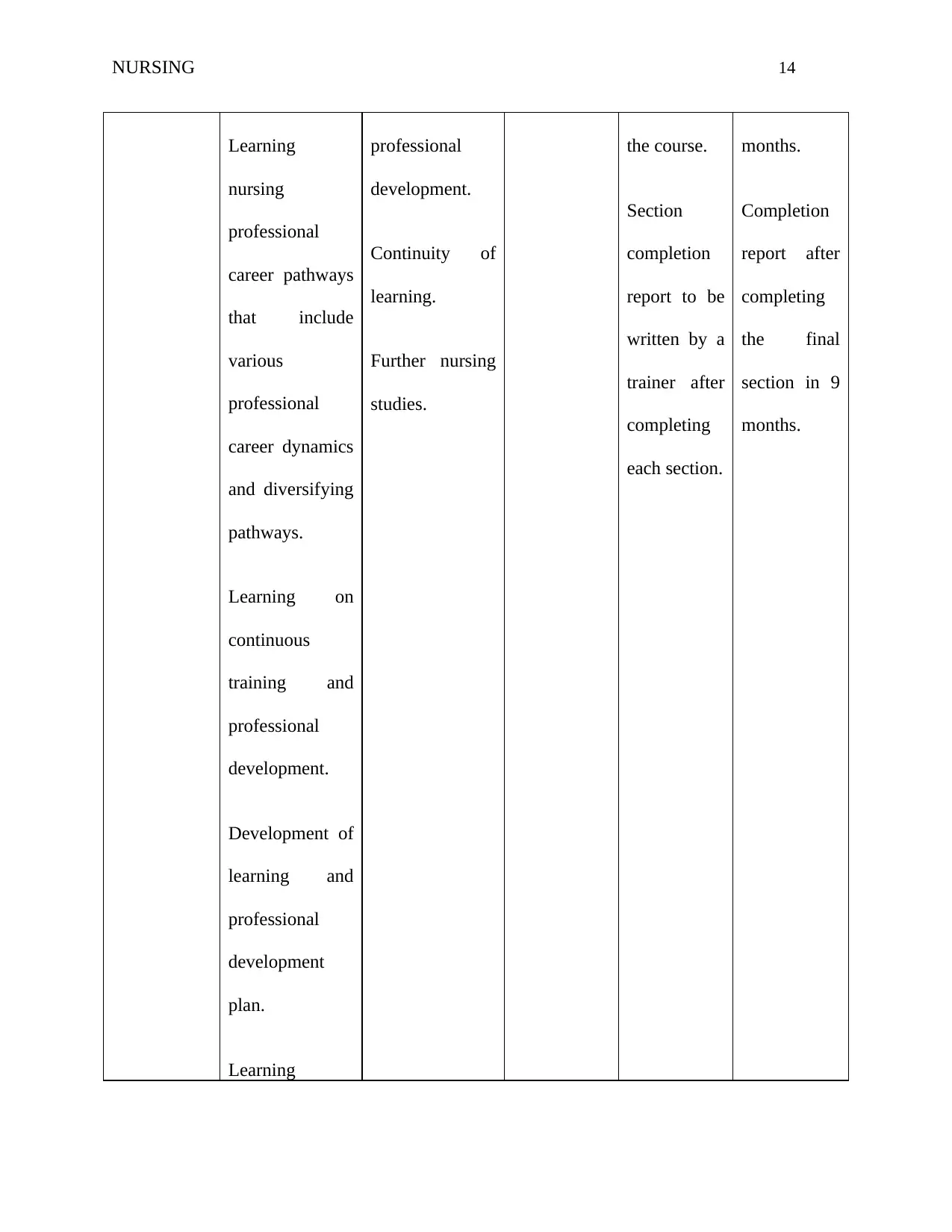
NURSING 14
Learning
nursing
professional
career pathways
that include
various
professional
career dynamics
and diversifying
pathways.
Learning on
continuous
training and
professional
development.
Development of
learning and
professional
development
plan.
Learning
professional
development.
Continuity of
learning.
Further nursing
studies.
the course.
Section
completion
report to be
written by a
trainer after
completing
each section.
months.
Completion
report after
completing
the final
section in 9
months.
Learning
nursing
professional
career pathways
that include
various
professional
career dynamics
and diversifying
pathways.
Learning on
continuous
training and
professional
development.
Development of
learning and
professional
development
plan.
Learning
professional
development.
Continuity of
learning.
Further nursing
studies.
the course.
Section
completion
report to be
written by a
trainer after
completing
each section.
months.
Completion
report after
completing
the final
section in 9
months.
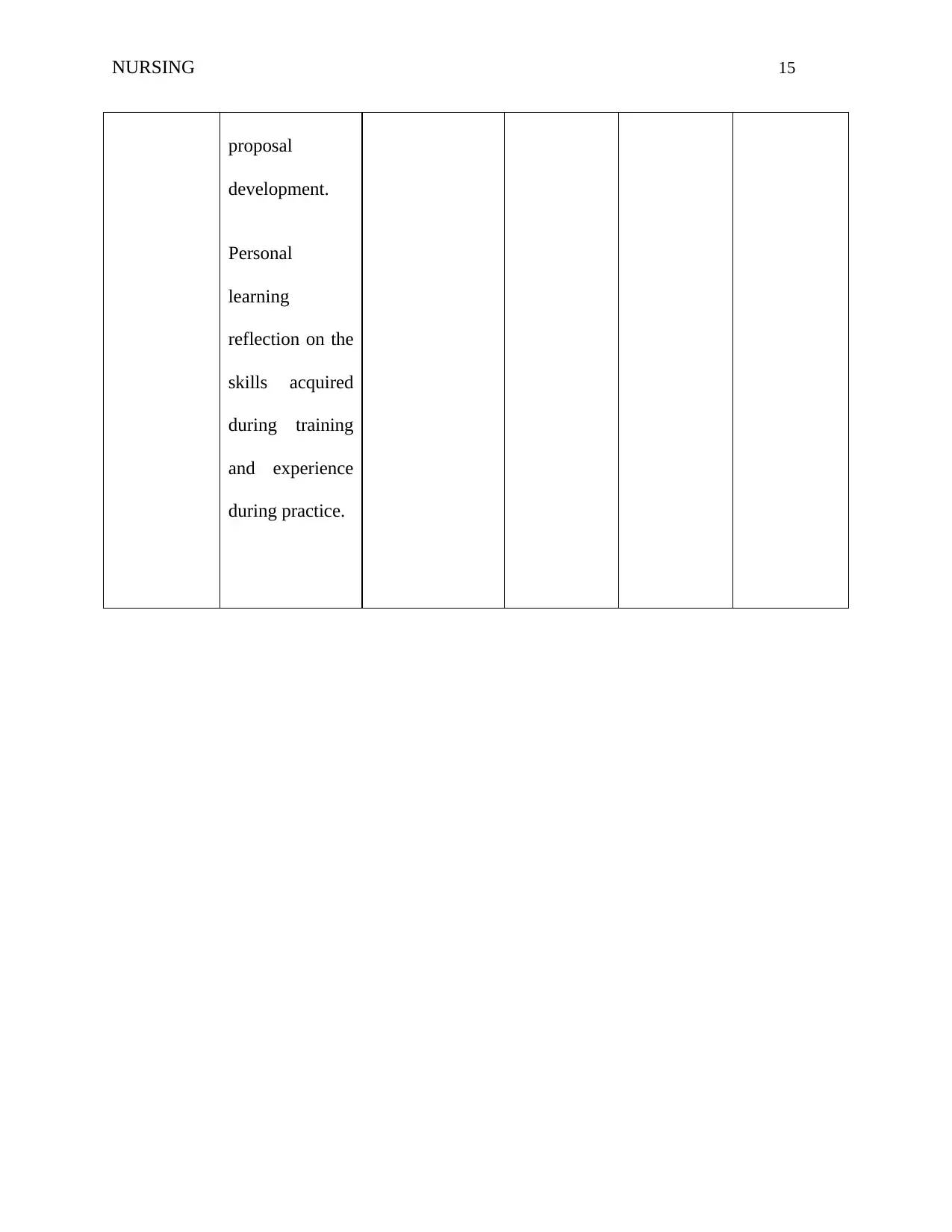
NURSING 15
proposal
development.
Personal
learning
reflection on the
skills acquired
during training
and experience
during practice.
proposal
development.
Personal
learning
reflection on the
skills acquired
during training
and experience
during practice.
1 out of 15
Related Documents
Your All-in-One AI-Powered Toolkit for Academic Success.
+13062052269
info@desklib.com
Available 24*7 on WhatsApp / Email
![[object Object]](/_next/static/media/star-bottom.7253800d.svg)
Unlock your academic potential
© 2024 | Zucol Services PVT LTD | All rights reserved.





